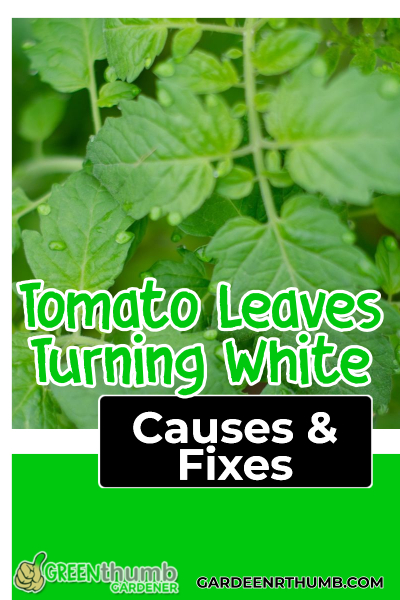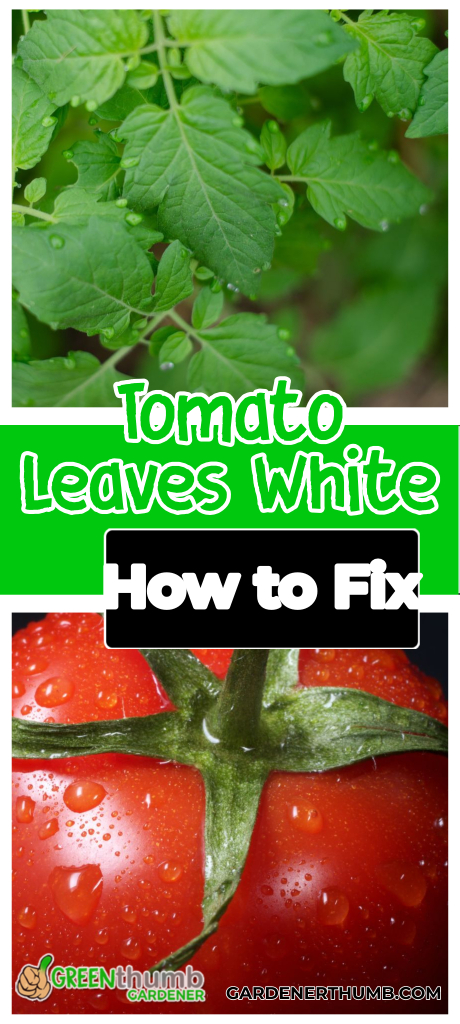Tomato Leaves Turning White | Causes & Treatments
Tomatoes always earn a special spot in everyone’s garden. They are usually easy to grow and can provide a good amount of fruit if growing conditions are optimal.
Yes..tomatoes are fruit.
But, you might be here to find out why your tomato plant leaves are turning white.
Don’t sweat it, you will know what to look for and what to do to fix it by the end.
Affected tomato plants are susceptible to extreme cold and prolonged exposure to direct sunlight. Because of this sensitivity to temperature and light, they are vulnerable to acquiring white spots on their leaves.
However, white spots & areas that cover the entire plant leaves could be caused by various other factors.
Are you ready to learn what to do to affected plants?
Green thumb Gardener occasionally links to product and/or services offered by vendors to assist you with all your gardening needs. Some of these may be affiliate links, meaning we earn a small commission if items are purchased.
Want to Download a Garden Hack Guide for FREE

Enter your email below and we will send you a guide to help you SAVE money in your garden.
Listen to this post on the Green thumb Gardener Podcast
Subscribe to the Green Thumb Gardener Podcast on iTunes, Spotify, Or Google Podcast HERE
Why Are My Tomato Leaves Turning White?
The problem of tomato leaves turning white is a prevalent issue affecting tomato plants. Tomato plant disease, intense sunlight, nutrient deficiencies, cold weather, and fungal diseases like powdery mildew are all common causes of silver or white leaves on tomato plants.
Mostly, these factors are responsible for the white leaf color. Tomato growers identify the cause of the issue and implement corrective steps.
Over Exposure To Sunlight
Your own tomato plants are susceptible to changes in temperature, including those brought on by harsh sunlight. It is essential to take extra precautions to avoid damage from exposure to sunshine, especially if you are cultivating a tomato seedling.
Excessive direct sun exposure causes tomato plant’s leaves to turn white or light brown and crisp. In addition, they can also lose their regular shapes and become irregular.
Sun scalding occurs when transplants grown in a greenhouse or indoors are immediately placed in the garden without the correct hardening-off process.

Gradually acclimatizing the plants can help them recover and produce more fruit. However, younger plants typically have delicate, sparse foliage that is highly vulnerable to the intense sunlight that occurs during the middle of the day.
The tomato plant must get some indirect sunlight or morning sun so they will not have sunburn.
Fungal Diseases
If the leaves on your tomato plants are discolored in any way, mainly if they are white, brown, or yellow patches on leaves, you may have an infestation of fungus in your garden plants.
Fungal diseases are a pervasive tomato plant problem and are primary cause by over-watering the plants. Infected plants can have leaves with black borders around white dots and are easy to identify.
Some examples are root rot, Alternaria, and septoria leaf spot.
Powdery mildew is another possible culprit behind the white patches on tomato leaves. Powdery mildew on tomato plants is a contagious fungal disease that can be carried to healthy leaves by woolly aphids.
This condition affects plants and wreck havoc.
As a result, the leaves take on a powdery white appearance that quickly spreads and causes damage to plants.
Excessive or Lack Of Nutrients
In some cases, excessive or insufficient nutrient intake may be to blame for whitening the leaves of your tomato plants. For example, tomato plants sometimes suffer from white leaves because they may lack one of the following nutrients:
- Calcium
- Magnesium
- Nitrogen
- Phosphorus
If a plant is deficient in nitrogen or phosphorus, the color of its leaves may change from green to white or yellow.
Inadequate levels of calcium or magnesium can also cause leaves to turn yellow, although the veins of the leaves will maintain their green color.
The nutrients and minerals tomato plants require can be acquired either via the use of fertilizers specifically prepared for tomato crops or by applying compost.
Low-Temperature Exposure
Tomato plants are hardy enough to withstand temperatures as low as 33 degrees Fahrenheit, but they begin to experience difficulties when the temperature drops below 50 degrees Fahrenheit.
If you leave a tomato plant outside in the cold without providing any protection, the plant may sustain significant damage, and the tomato leaves may turn white.
The tomato plant will develop white spots on its leaves if the temperature drops below what the plant considers optimal. When the temperature drops, the tomato plant will have curled leaves, which protect the plant and keep the heat.
Pest Damage
The presence of white dots on tomato leaves could be an indication of an infestation. If you have eliminated all other potential causes, then you should look for insects. You will need to look very carefully because many of the sneakier bugs are challenging to spot.
There are a significant number of pests that would enjoy making a meal out of your tomato plants if given a chance.
You’ll need to keep a sharp eye out for these annoying pests in the garden, which could include aphids, mites, or other insects.
Examine the area opposite the light source for any tiny shadows.
Aphids can be a significant source of frustration for tomato farmers.
However, they are quite common, and scientists have identified around 5,000 distinct species.

Sap-eating insects can be found on the underside of leaves, so you have to look under the leaves and fresh foliage.
Catching pests early on, before they can cause an infestation, is the most effective method for getting rid of them. It is important to get rid of aphids and other insects and pests as soon as possible in the spring since they reproduce so quickly.
Ways To Prevent Tomato Leaves From Turning White
The following are some preventative measures to stop the leaves on your tomato plants from becoming white.
1. Proper Hardening
It is crucial to allow tomato seedlings to acclimate to their new environment before transplanting them. Hardening involves progressively exposing tomato plants to the outside environment by removing the plants from the pot and placing them in a well-shaded place.
Hardened leaves that were progressively exposed to outside light are less prone to suffer from sun-scald than those that have not. This can be done through proper hardening before they are transplanted outdoors.
For example, tomatoes can be hardened about two weeks before being put outside permanently to avoid damage from full sun.
Begin by putting them in full shade for located plants indoors; they will be ready for a brief exposure to the sunlight after two to three days in the shade. Once the plants can tolerate direct sunlight, increase their daily sun exposure by 15-30 minutes every day for at least 10 days.

Further Reading
2. Control Fungi Growth
One of the most common causes of a fungal infection is excess water. A moist and warm environment could lead to the growth of fungus on the leaves of your tomato plant.
Keep your tomato in well-drained soil and follow the proper watering schedule.
Tomato plants require approximately one to two inches of water a week. This will prevent the roots from becoming overly wet, which is a favorable environment for the growth of fungi and fungal spores.
In addition, the plant should be kept in a well-ventilated area with plenty of light.
As an additional precaution, avoid drenching the plant’s leaves in water and instead direct the water flow into the area where the roots are located. If you have a fungus infestation, your best option is to purchase a fungicidal agent and apply it to your damaged leaves.
This over-the-counter fungicide is available from your local pharmacy.
3. Provide Proper Nutrients
White leaves on tomato plants can occur whenever there is a deficiency of calcium, magnesium, nitrogen, or phosphorus. Using a tomato fertilizer that already contains these nutrients in the ideal quantities is probably the most effective method.
You can ensure that your tomato plants are receiving all of the nutrients they require by fertilizing them with proper amounts of all-purpose fertilizer. These minerals encourage healthy plant growth and will stop the leaves of the tomato plant from turning white.
You also want to ensure you do not give them too many nutrients as well.
4. Control Pests
Pests such as worms, flies, and mites can wreak havoc on tomato crops. For example, Aphids can spread diseases to your tomatoes, so controlling pests is essential.
It’s a good idea to introduce some beneficial insects to your garden to eliminate these pesky pests.
Additionally, a hose-mounted water jet can be used to knock them off the plants and reduce their population. Soap, neem oil, and rotenone dust are examples of organic pesticides that can be used to control these pests.
Final Thoughts
White tomato leaves could be due to any number of factors. Some of these issues can be addressed by simply moving the plant, using fertilizers, or reducing the water it receives.
However, it is essential to deal with it as quickly as possible to avoid causing lasting damage to your tomato plants.
Related Questions
Can white leaves turn green again?
No, your white leaves won’t become green again.
However, newer green leaves will appear if you can fix the issue causing it, such as overexposure to sunshine, a lack of nutrition, or a fungal disease.
Should I cut off sunburned leaves?
Yes. By removing these leaves, you can help the healthy leaves absorb more nutrition, enhancing the plant’s appearance.







